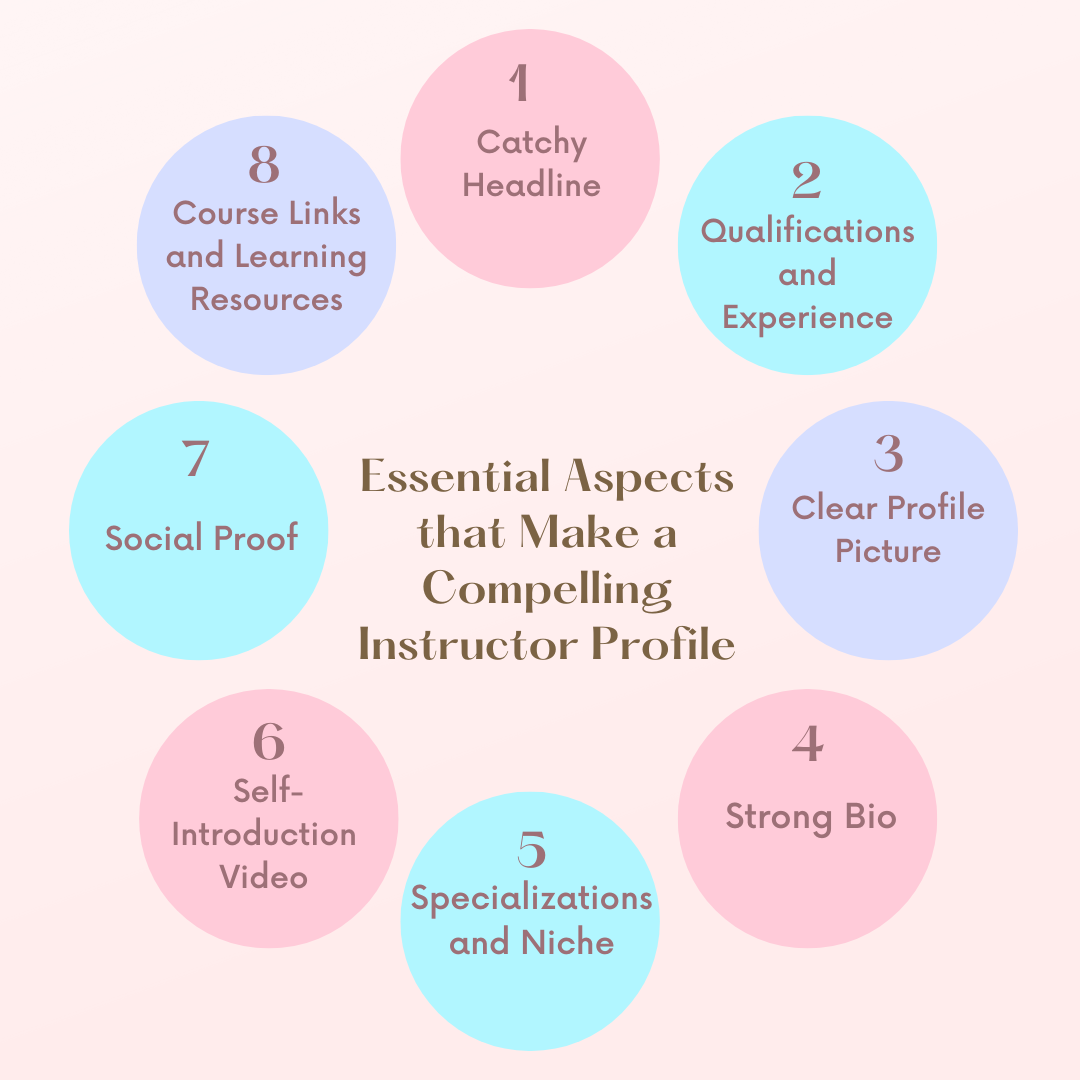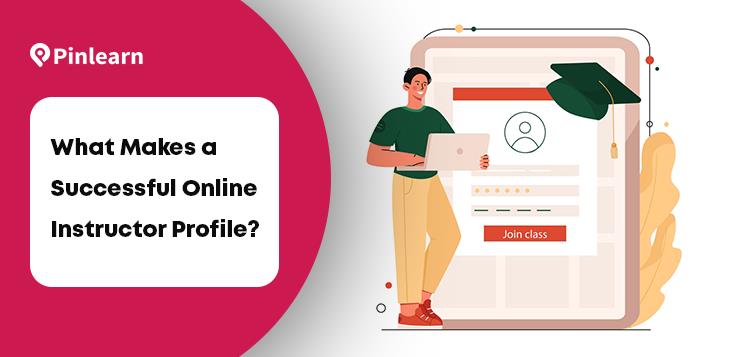How to Write a Compelling Instructor Profile (9 Key Tips)
Are you promoting your profile on a tutoring marketplace or as a freelance tutor? You need a compelling instructor profile to attract the right students. But what’s the trick to make an eye-catching instructor profile?
While mentioning too many skills and specializations might sound salesy, you cannot skip the key details. Besides, the tone and style of your profile also matter!
This blog guides you to craft a perfect instructor profile and capture students’ attention. So, are you ready to make the right impression?
9 Essential Aspects that Make a Compelling Instructor Profile
A strong instructor profile communicates your unique business proposition, wins trust & credibility. Besides, it’s essential to understand what students are looking for in your profile.
Here’s a list of key details to add to your instructor profile:

1. Captivate with a Catchy Headline
Your headline should go beyond describing who you are. It must captivate learners’ attention and show how learners can reach their goals. Since it appears at the top of your profile, it must be catchy and pique curiosity.
A compelling headline should show your area of expertise, credibility, and unique impact. Since your entire profile isn’t shown in the results, only the headline and bio are shown. Hence, your headline must be impactful!
Here are the key elements of a headline that showcase your credentials:
-
Teaching Speciality
Whether it’s language tutoring, STEM, or special education, speaking about your teaching speciality is an absolute essential. This persuades your learners about your expertise.
-
Education Credential
Include relevant degrees and certifications to demonstrate your credibility and commitment to your niche. For example, a Master’s in English, or a Cambridge Graduate.
-
Achievements and Contributions
Embedding your most remarkable achievements in your headline polishes your profile. It distinguishes your profile from other competitors. For instance, use keywords like “award-winning educator”, “certified art teacher”, and “10 years of expertise in special education.”
-
Impactful Skills
Highlight your teaching competencies like “student-centred tutor” or “instructional design.” This portrays your unique contributions and expertise.
-
Student-focused Outcomes
A learner-centric headline using keywords like “helping learners build confidence” and “empowering students” makes a powerful statement.
A great headline piques interest and lands you exciting educational opportunities!
2. Specify Your Qualifications and Experience
One of the basic things an instructor’s profile must include is educational background and real-world experience. You don’t have to chronicle all your qualifications and achievements to date. Summarize the essential details of educational and teaching experiences in the last few years.
Here are a few common details your profile must possess:
- Your graduate or post-graduate degree
- TEFL/TESOL certificate or other key certifications
- Number of years of teaching experience
- The kind of students you’ve worked with (e.g., elementary, middle/high school, dyslexic)
- Whether you specialize in one-to-one or group sessions
- The universities, companies, or institutions you’ve worked in the past
Example:
“I am a double major in Applied Mathematics and Quantitative Economics. I have been tutoring students in mathematics since my high school in both offline and online settings. Over the years, I have helped students struggling with Maths at MIT, Berkeley, and Stanford.”
3. Choose a Clear Profile Picture
A clear and professional profile pic is one of the first things students notice in a profile. Ensure your profile photo is professional and has a friendly expression. While capturing your photo, ensure high resolution and good lighting.
Avoid blurry or low-quality images, as that doesn’t add value to your profile. If you’re targeting professional education, opt for a business casual look. This includes neutral background colours and professional attire. But if you’re attracting young learners, choose vibrant colours in your attire.
Your profile picture should be shoulder up and flaunting a smile to show a warm demeanour.
4. Write a Strong Bio
A strong bio could be game-changing for your instructor profile. It is a brief introduction about yourself, capturing your education, skills, experience, and certifications in a few words.
A bio is typically short, around 100 to 300 words, and captures the essence of your profile.
Want your profile to stand out? Add a personal touch with your teaching philosophy or unique perspective that motivates learners. This could be something like, “I focus on making learning fun and interactive. So, I add stories, games, and discussions to make my reading and writing sessions more enjoyable.”
Your teaching bio is one of the first things read by teachers and parents. So, ensure it answers who you are, what you teach, and why they must choose you.
Here are a few points to consider for an effective bio:
- Start with basic information and then later cover additional details. Keep it short and simple.
- Add a personal touch with your hobbies, interests, and goals.
- Write as if you’re talking to get that perfect tone and voice
- Spark curiosity or roll in some humour to make it engaging
Example:
“I am a writer and college essay specialist with over 15 years of writing experience. I have majors in English and Spanish and minors in History and French. And I work with elementary students, graduates, and medical school applicants for language requirements. I am adept at writing essays, blogs, memoirs, newsletters, social media content, etc. When I am not teaching, I am a book nerd or binge-watch sitcoms and crime dramas.”
5. Highlight Your Specializations and Niche
Do you specialize in a particular field, like Business English or Spanish tutoring? Highlight this in your profile and also mention your past experiences related to the niche.
Include the specific keywords like “Business English”, “Functional Fitness” or “Special Education.” This makes your profile more discoverable and accessible. To add more credibility, support them with certifications, degrees, and achievements.
For example, if you specialize in early childhood education, highlight your expertise like “curriculum development” and “special education.” This proves your versatility, and to quantify your impact, you could mention that you “mentored over 300 students and were a Former Senior Teacher at Pearson.”
6. Add a Self-Introduction Video
How can you create an eye-catching instructor profile? Besides a professional profile picture and a compelling bio, a short self-introduction video can do the trick!
A 1-2 minute short introductory video can help you build a rapport with your students.
Speak about your expertise, qualifications, and teaching style. Your body language matters, so keep a radiant smile and friendly demeanor through the video. This radiates positive energy and makes you appear welcoming and friendly. Appear natural and use friendly gestures and body language.
Practice your script beforehand, so you can appear natural while recording the video.
Here’s a quick script for your self-introduction video:
- Introduce yourself (15-20 seconds): What is your name? Where are you from? What do you teach and which languages?
- Describe your skills (30-50 seconds): What are your qualifications, expertise, and skills relevant to teaching? What kind of learning materials and resources do you use while teaching? Do you specialize in specific niches? Do you use any specialized teaching method? Whom do you teach? (beginners, intermediates, or experts)
- End the video (last 15-20 secs): End the video with a motivational message and persuade them to book a demo session with you.
Technical requirements for filming your introductory video:
- Record the video when there is natural light, or use a lamp or ring light if recording at night
- Ensure your background is clean and has neutral colors to avoid distracting attention
- Record in a quiet place, where there isn’t any background noise. Use headphones or microphones for better sound quality
- Position your camera at eye level and ensure it is in horizontal mode
- Avoid applying any filters to your video, and perform a test shot before recording the final video
Save your video in MP4.MPEG4 and MOV format. If you uploaded your video on YouTube or a third-party website, add the link in your profile.
7. Display Social Proof
In this competitive market, testimonials and reviews serve as testament to your credibility. It’s a hands-on marketing tool that fosters trust, credibility, and the true value of your course. After all, learners trust existing learners more than anything else. Word-of-mouth marketing still hasn’t lost its charm!
If you’re uploading your instructor profile on a marketplace, you could add course reviews or student testimonials.
Here are some practical ways to collect student testimonials:
- Ask for feedback when a student completes a course
- Offer guidelines for submitting video testimonials
- Gather social media reviews about your course from LinkedIn, Facebook, X (Twitter)
- Incentivize testimonials with discounts, early-bird offers or exclusive content
- Follow up with students for feedback if they are impressed with your course
8. Add Links to Courses and Learning Resources
If you already have a few courses and resources to your credit, why not add them to your profile? You could add course previews, resources or bonus materials to your profile.
Add attractive descriptions (e.g., enrol to my “ The Complete SQL Bootcamp”, watch my SQL for beginners video on YouTube) to make links more action-oriented.
Another way to add links is through contextual linking. Just highlight a skill or expertise and relate it to your course. For multiple resources, use link aggregators like Linktree, Notion page, etc.
9. Keep Your Profile Updated
As you climb your success ladder as an instructor, keep updating your instructor profile. Review your profile for your recent qualifications, expertise, or experiences. For example, you might have completed a recent TESOL certification. Then, don’t forget to include it in your instructor profile.
Ensure you share your success stories and achievements and don’t miss out on anything! This ensures your profile includes all the relevant keywords and is easily discoverable. Periodically revise your photo, bio, and contact information to display accurate information.
Mistakes to Avoid While Creating an Instructor Profile
Your instructor profile is a hands-on marketing aid that proves your craft. So, to make the right impression, it’s essential to avoid blunders in your profile. Even the smallest mistakes might hinder learners from connecting with you!
Here’s a list of profile mistakes to avoid and put your best foot forward:
-
Neglecting Your Target Audience
As an instructor, you have a specific target audience. Your potential clients might be K-12 students, linguists, or corporate professionals. Keep their needs, expectations, and pain points in mind while making your profile.
-
Incomplete Profile Information
An incomplete profile does no good to you as an instructor! Skipping the key details of your educational background, certifications, or achievements can turn costly.
-
Low-Quality Profile Photo
A blurry, unprofessional or missing profile photo is a big turn-off for your profile. It reduces your credibility and makes you less approachable.
-
Lack of Testimonials or Social Proof
Whether it’s a course review, video testimonial, or social media review, social proof makes your profile stand out! So, don’t miss out on this game-changing detail! Reach out to early or existing learners to collect honest reviews.
-
Not Showing Your Unique Selling Proposition
Your instructor profile portrays a facet of your profession, or perhaps yourself. Hence, it must be as unique as you are! So, spice it up by adding your unique teaching style or philosophy. You can speak for your learners or motivate them!
Wrapping Up
Creating a strong instructor profile involves the right blend of expertise, credibility, and uniqueness. You need to demonstrate who you are and also resonate with students and parents.
So, before sketching an outline of your profile, get the groundwork done! Research a bit about your audience and current market trends. Whether you are an educator finding your chance in the course or tutoring industry, follow these tips to turn the tables! So, good luck as you build your career as an amazing educator!
FAQ-Related to What Makes a Successful Online Instructor Profile
1. What are key points to include in my instructor profile bio?
The headline and bio are one of the most important sections of your instructor profile. Ensure it demonstrates your qualifications, experience, and credibility.
Here are some essential sections of your bio:
- Qualifications, experience, and expertise
- Specialization and niche
- Teaching philosophy
- Learning goals
- Your personality and personal interests
2. How long should your profile bio be?
An ideal profile bio is around 100 -300 words and must capture the essence of your entire profile. Ensure it is easy to read, concise and attracts learners to your profile.
3. What common mistakes should I avoid while writing an instructor profile?
Here are some common mistakes to avoid in your instructor profile:
- Avoid technical jargon; use clear, easy-to-read language
- Check for any spelling or grammatical errors
- Avoid an unstructured layout or overloading your profile with too much information
- Don’t use overly casual profile pictures and too bright colors
- Writing your profile for a generic audience with a weak summary
- Not quoting any real work experiences or examples
4. What is a crucial skill for instructors in an online learning environment?
Effective communication, organization, time management, and technical know-how are the crucial skills for online instructors.





